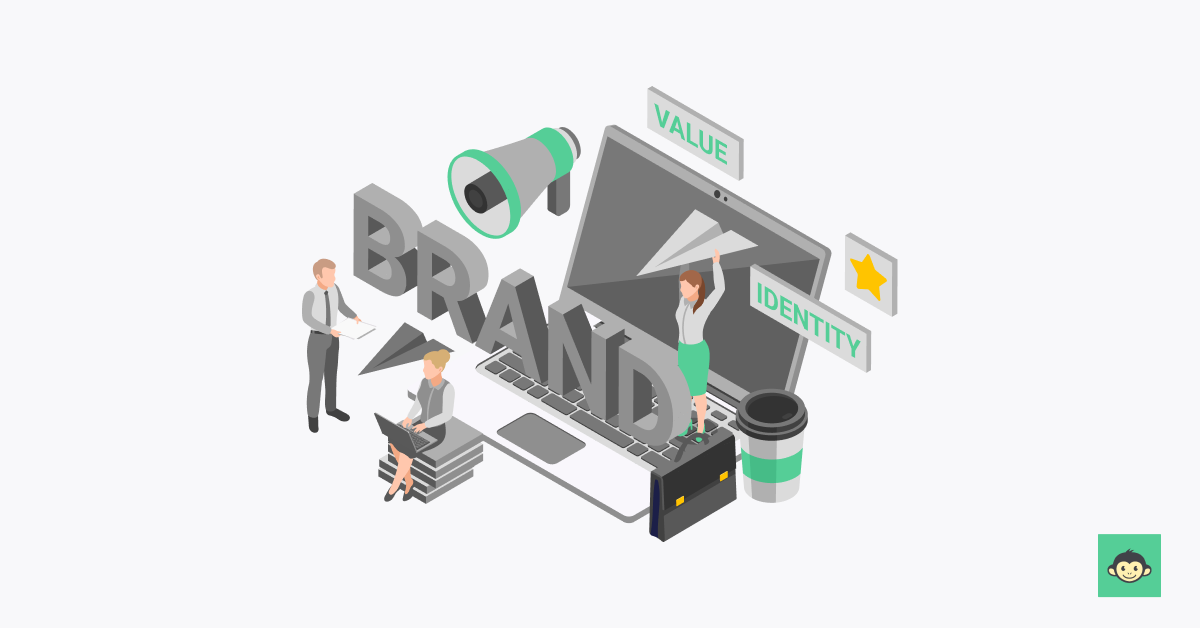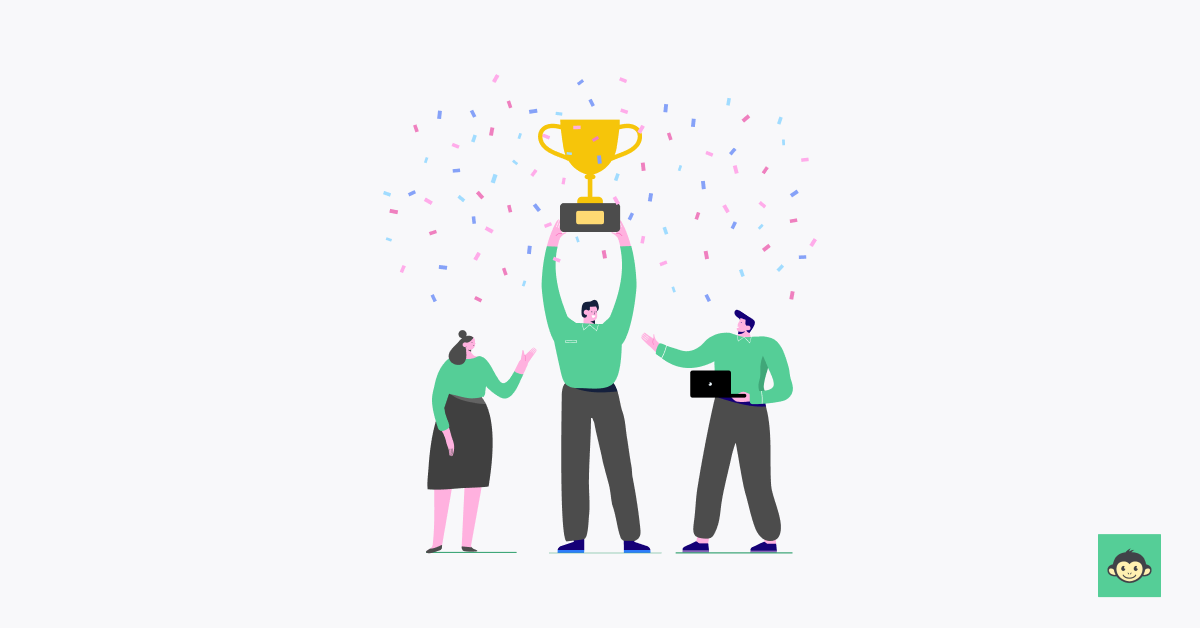Employee branding 101: Attract top talent & become the employer of choice in 2024

Imagine your company as a beacon, attracting the best talent in the industry. Not just because of attractive salaries or fancy perks, but because your future employees will rave about the experience, the culture, and the impact they make. This is the magic of employee branding.
Forget traditional employee branding focused on outbound marketing. Employee branding is about flipping the script, empowering your people to become your most vocal advocates. It's about creating a workplace where happiness isn't a perk, it's the foundation.
Ready to unlock the potential of your greatest asset? In this blog, we'll delve into the what, why, and how of employee branding, equipping you with actionable strategies and inspiring examples to build a brand your employees love to represent. So, buckle up and get ready to turn your company into a talent magnet!
What is employee branding?

Employee branding is the strategic process of shaping and promoting a company's reputation as an employer. It involves creating a compelling identity that showcases the company's values, culture, and staff experience to attract and retain top talent.
In essence, employee branding focuses on how a company is perceived by both current and new employees, as well as external stakeholders. It goes beyond traditional marketing efforts aimed at customers and clients to cultivate a positive image specifically tailored to the workforce.
Employee branding is not just a marketing message about showcasing the perks and benefits of working for a company; it's about authentically communicating the organization's mission, values, and culture.
It's about creating a strong employer value proposition (EVP) that resonates with employees and aligns with the company's overall brand.
Why is employee brand important?

Employee braning is critically important for organizations for several reasons:
- Attracting top talent: In a competitive job market, having a strong employee brand helps organizations stand out and attract the best talent. Potential candidates are drawn to companies that are known for their positive workplace culture, values, and staff experience.
- Retaining employees: A strong employee brand not only helps attract talent but also plays a crucial role in retaining existing employees. When employees are connected to the company's values and culture, they are more likely to stay with the organization, reducing turnover rates and preserving institutional knowledge.
- Enhancing company brand reputation: Branding doesn't just impact internal stakeholders; it also affects external perceptions of the company. A positive employee brand enhances the company's reputation in the eyes of clients, investors, and the general public, which can lead to increased business opportunities and support.
- Increasing a great employee brand and engagement: Employees who feel aligned with the company's mission and values are more engaged and motivated in their work. A strong employee brand fosters a sense of pride and belonging among employees, leading to higher levels of productivity, performance, and innovation.
- Boosting employee referrals: Satisfied employees become brand advocates, referring top talent to the organization. Employee referrals are often high-quality candidates who are a good fit for the company culture, resulting in more successful hires and reducing recruitment costs.
- Supporting recruitment efforts: A positive employee brand makes it easier to recruit new and retain talent, as job seekers are more likely to be attracted to companies with a strong reputation as employers. This can lead to a larger pool of qualified candidates and a shorter time-to-fill for open positions.
- Fostering a positive work environment: It contributes to creating a positive work environment where employees are valued, respected, and supported. This, in turn, leads to higher levels of job satisfaction, morale, and overall well-being among employees.
- Driving business success: Ultimately, employee branding is not just about attracting and retaining talent; it's about driving business success. Engaged and satisfied employees are more committed to the company's goals and are willing to go the extra mile to contribute to its success, ultimately impacting the bottom line positively.
5 Employee branding strategy benefits you should be aware of

Unlocking the full potential of employee branding offers myriad benefits beyond talent acquisition and retention. Here, we delve into five additional advantages that can drive organizational success.
1. Building a diverse workforce
A strong employee brand can attract a diverse pool of talent. Companies with inclusive cultures and a reputation for valuing diversity are more likely to appeal to individuals from various backgrounds, experiences, and perspectives.
2. Improving customer relations with company values
Employees who are engaged and aligned with the company's values are more likely to deliver exceptional customer service. A positive employee brand can enhance customer loyalty by ensuring consistent, positive interactions with workers who embody the company's values.
3. Boosting innovation and creativity:
A supportive work environment where workers are valued and empowered fosters innovation and creativity. Staff who are encouraged to share ideas and take calculated risks are more likely to innovate and contribute to the company's growth and success.
4. Strengthening employer-employee relationships
Employee branding initiatives, such as recognition programs and opportunities for career development, can strengthen the relationship between employers and workers.
5. Enhancing Employer Value Proposition (EVP)
An effective strategy can enhance the company's EVP, making it more attractive to potential candidates. A compelling EVP communicates the benefits and advantages of working for the company, helping to differentiate it from competitors and attract top talent.
How do you build an employee brand?

Define org values and culture:
- Identify and articulate the core values that define the company's identity and culture.
- Ensure alignment between organizational values and employee experiences to create authenticity in the workplace.
Develop employee branding strategy:
- Formulate a comprehensive employee branding strategy that outlines specific goals, tactics, and timelines.
- Incorporate elements such as Employer Value Proposition (EVP), employee journey mapping, and employee brand audit to guide strategy development.
Implement employee branding initiatives:
- Roll out initiatives that highlight the company's strengths and unique selling points as an employer.
- Showcase employee success stories, testimonials, and experiences to reinforce the employee brand and attract potential candidates.
Encourage employee advocacy:
- Empower staff to become brand ambassadors by providing them with resources and platforms to share their experiences.
- Foster a culture of advocacy by recognizing and rewarding staff who actively promote the company's brand.
Leverage social media for brand amplification:
- Utilize social media platforms to amplify the company's employee brand message and engage with current and potential workers.
- Share behind-the-scenes content, company updates, and employee-centric stories to humanize the brand and connect with audiences.
Increase employee satisfaction:
- Implement initiatives to enhance employee satisfaction and well-being, such as wellness programs, flexible work arrangements, and recognition schemes.
- Regularly gather employee feedback through surveys, focus groups, and one-on-one discussions to identify areas for improvement and address concerns.
Invest in development opportunities:
- Provide staff with opportunities for skill development, career advancement, and continuous learning.
- Offer training programs, mentorship initiatives, and tuition reimbursement to support employee growth and development.
Enhance internal communications:
- Establish clear and transparent communication channels to keep staff informed about company updates, goals, and initiatives.
- Foster a culture of open dialogue and feedback to promote engagement and alignment with organizational objectives.
Promote employee engagement:
- Encourage employee participation in decision-making processes and company events to foster a sense of ownership and belonging.
- Recognize and celebrate employee achievements, milestones, and contributions to reinforce a positive work environment.
Consistently reinforce company mission and values:
- Integrate org values and mission statement into daily operations, decision-making processes, and employee interactions.
- Ensure that leaders and managers exemplify the company's values and serve as role models for staff to emulate.
By following these steps and continually refining their recruiting efforts, organizations can build a strong employee brand that attracts, retains the best employees while enhancing the company's reputation and competitiveness in the marketplace.
10 Employee brand activities and ideas to try in 2024

1. Employee recognition programs
Establish a structured employee recognition program that includes various forms of recognition such as shout-outs in team meetings, peer-to-peer recognition, and formal awards.
Provide tangible rewards such as gift cards, certificates, or extra paid time off to incentivize exemplary performance and reinforce desired behaviors.
Regularly celebrate employee milestones, anniversaries, and achievements to encourage employees and foster a culture of appreciation and acknowledgment within the organization.
2. Employee advocacy workshops
Host workshops or training sessions focused on personal branding, social media best practices, and the role of staff as brand ambassadors.
Equip staff with the knowledge and skills to effectively represent the company's brand values and messaging in their online and offline interactions.
Encourage staff to share their experiences and insights on social media platforms, highlighting the positive aspects of working for the company.
3. Virtual employee engagement events
Organize virtual team-building activities such as virtual escape rooms, online trivia contests, or themed costume parties to foster camaraderie and team spirit.
Offer virtual wellness workshops covering topics such as stress management, mindfulness, and healthy living to support employee well-being and work-life balance.
Facilitate virtual coffee breaks or happy hours where staff can socialize, connect, and unwind in a relaxed setting outside of work tasks.
4. Employee takeover days on social media
Develop guidelines and criteria for staff interested in participating in social media takeover days, ensuring alignment with the company's brand values and messaging.
Encourage staff to share authentic and engaging content, including photos, videos, and personal anecdotes that offer a glimpse into their daily work life.
Monitor and moderate employee-generated content to maintain consistency with the company's brand identity and standards for professionalism and confidentiality.
5. Company-wide hackathons or innovation challenges
Define clear objectives and themes for hackathons or innovation challenges that align with the company's strategic goals and areas of focus.
Provide cross-functional teams with access to resources, tools, and mentorship to support their ideation and prototyping efforts during the event.
Showcase the outcomes and insights generated from hackathons or innovation challenges through internal presentations, reports, or showcases to inspire further innovation and collaboration.
6. Employee learning and development opportunities
Offer a variety of learning and development opportunities, including online courses, workshops, seminars, and conferences, to accommodate different learning styles and preferences.
Create personalized development plans for staff based on their career aspirations, skill gaps, and performance feedback to support their professional growth and advancement.
Foster a culture of continuous learning and knowledge-sharing by encouraging staff to pursue ongoing development opportunities and share their expertise with colleagues.
7. Employee spotlight features
Showcase employees' stories, accomplishments, and contributions through written profiles, interviews, or video testimonials featured on the company's intranet, newsletter, or social media channels.
Highlight diverse perspectives and experiences across various departments, roles, and levels within the organization to promote inclusivity and representation. Ask staff to nominate their peers for spotlight features and recognize individuals who embody the company's values and make a positive impact on the organization.
8. Employee referral programs with incentives
Because a bad brand reputation equals a bad work environment, it is important to have positive employee branding since the current employees' referral and positive feedback can provide you with a ready-made talent community, ready to get hired.
Promote the employee referral program through multiple channels, including email current employees' newsletters, company meetings, and social media, to raise awareness and encourage participation. Utilize LinkedIn Sales Navigator email extractor to gather potential referrers’ contact details and send personalized outreach, further amplifying program visibility and engagement. When reaching out to employees or referrers, ensure you have their LinkedIn URL format for easy connection and tracking within your network.
Offer attractive incentives for referrals, such as monetary rewards, prizes, or exclusive perks, to incentivize staff to actively participate in the program.
Provide clear guidelines and communication about the referral process to current employees, eligibility criteria, and rewards structure to ensure transparency and fairness in the program.
9. Virtual town hall meetings with leadership
Schedule regular virtual town hall meetings with senior leadership to provide updates on company performance, strategic initiatives, and organizational changes.
Create opportunities for staff to ask questions, share feedback, and engage in dialogue with leadership during town hall sessions to foster transparency and communication.
Share meeting recordings or summaries with staff who are unable to attend live sessions to ensure inclusivity and accessibility for all team members.
10. Leadership development programs
Implementing leadership development programs is crucial for fostering a pipeline of skilled leaders within the organization. These programs aim to identify and cultivate high-potential employees, equipping them with the necessary skills, knowledge, and competencies to excel in leadership roles.
By offering mentorship, coaching, and targeted training opportunities, employees can enhance their leadership capabilities and readiness for future career advancement.
Leadership development programs not only benefit individual employees but also contribute to the long-term success and sustainability of the organization by ensuring a strong leadership bench and continuity in leadership succession planning.
By incorporating these additional activities and ideas into your strategy, you can further enhance your employee brand, engage employees, and strengthen your organization's reputation both internally and externally.
7 Examples to take inspiration from

1. Salesforce: Ohana culture
Salesforce, a cloud-based software company, is renowned for its "Ohana" culture, which emphasizes family-like values and inclusivity. The company prioritizes employee well-being through initiatives such as mindfulness programs, volunteer time off, and a focus on diversity and equality.
Employees often share their experiences on social media using the hashtag #SalesforceOhana, showcasing the company's commitment to its employees' success and happiness.
2. Google: Employee perks and benefits
Google is famous for its extensive employee perks and benefits, including on-site wellness and fitness centres, free gourmet meals, and generous parental leave policies.
These perks not only attract top talent but also contribute to a positive employee brand, with staff often sharing their experiences on social media platforms. Google's focus on employee well-being and work-life balance has become a hallmark of its employee brand.
3. Zappos: Customer service excellence
Zappos, an online shoe and clothing retailer, is known for its exceptional customer service, driven by its dedicated staff. The company's employee-centric culture encourages staff to go above and beyond to satisfy customers, with a focus on empowerment, autonomy, and personal connection.
Zappos' emphasis on employee happiness and engagement has earned it a reputation as a customer service leader and a desirable place to work.
4. Patagonia: Environmental stewardship
Outdoor apparel brand Patagonia has built its employee brand around environmental stewardship and sustainability. The company offers staff paid time off for volunteering, supports environmental causes, and promotes work-life balance through initiatives like flexible scheduling and on-site childcare.
Patagonia's commitment to its values attracts staff who share its passion for the environment and social responsibility.
5. HubSpot: Culture code
HubSpot, a leading inbound marketing and sales software company, has codified its company culture in its "Culture Code" document, which outlines its values, beliefs, and expectations for its staff.
The company fosters a culture of transparency, autonomy, and continuous learning, with real employees encouraged to share their ideas and feedback openly. HubSpot's commitment to its culture has helped it attract and retain top talent in a competitive industry.
6. Southwest Airlines: Fun and lightheartedness
Southwest Airlines is known for its fun and lighthearted company culture, which is reflected in its interactions with staff and customers alike.
The airline encourages staff to bring their authentic selves to work and promotes a sense of camaraderie and teamwork among staff. Southwest's emphasis on humor, friendliness, and employee empowerment has made it a beloved employer and a favorite among travelers.
7. IKEA: Employee development and growth
IKEA, the Swedish furniture retailer, prioritizes employee development and growth through initiatives such as training programs, leadership development opportunities, and career advancement pathways.
The company offers employees the chance to gain new skills, take on challenging projects, and pursue their career aspirations within the organization.
IKEA's investment in employee development not only enhances individual career prospects but also strengthens its employee brand as a place where employees can grow and thrive.
These real-life examples demonstrate the diverse ways in which companies can build compelling employee brands by prioritizing employee well-being, fostering positive company culture, encouraging employees, and aligning with core values and beliefs.
5 Best practices to keep in mind

- Authenticity and transparency: Ensure that your employee brand accurately reflects the reality of working at your organization. Be transparent about your company culture, values, and expectations. Authenticity builds trust with staff and helps attract candidates who align with your company's ethos.
- Employee engagement and involvement: Actively involve staff in shaping and promoting your employee brand. Encourage them to share their experiences, contribute ideas, and participate in advocacy initiatives. Engaged employees are more likely to become good employee brand and ambassadors and attract top talent to the organization.
- Consistent communication: Maintain consistent communication with staff at all levels of the organization. Regularly share updates, news, and achievements to keep staff informed and engaged. Consistent communication fosters a sense of belonging and strengthens the connection between employees and the company.
- Investment in employee development: Demonstrate a commitment to employee growth and development by offering learning opportunities, training programs, and career advancement pathways to educate employees. Investing in employee development not only enhances individual skills but also reinforces your company's reputation as a supportive and nurturing employer.
- Feedback and continuous improvement: Seek feedback from employees on their experiences, perceptions, and suggestions for improvement in good employee branding. Use this feedback to identify areas of strength and areas for growth within your employee brand. Continuously iterate and improve your employee branding efforts to ensure they remain relevant and effective over time.
By following these best practices, organizations can build a strong and compelling employee brand that attracts, retains, and engages top talent, ultimately driving business success and growth.
How to approach your employee branding strategies?

Approaching employee branding strategies requires a comprehensive and strategic approach that aligns with the organization's goals, values, and culture. Firstly, it's essential to conduct a thorough assessment of the current employee brand perception among staff, candidates, and external stakeholders.
This includes gathering feedback through surveys, focus groups, and employee interviews to understand strengths, weaknesses, and areas for improvement.
Once the EVP is established, organizations can develop targeted employee branding strategy and initiatives that reinforce key messages, enhance employee experiences, and attract top talent.
These strategies may include employee engagement programs, employee branding campaigns, talent attraction efforts, and ongoing communication to showcase the company's culture, values, and opportunities for growth.
Secondly, organizations should prioritize alignment between internal and external branding efforts to ensure consistency and authenticity.
Internally, employees should be actively engaged and involved in shaping the employee brand, with opportunities for feedback, recognition, and participation in advocacy initiatives.
Externally, the employee brand should be communicated consistently across various channels, including social media, career sites, job postings, and recruitment materials.
By fostering a positive employee experience and showcasing the organization's values and culture, organizations can build a strong employee brand that attracts, retains, and engages top talent, ultimately driving business success and competitiveness in the
How does branding improve employee morale?

Branding plays a significant role in improving employee morale by shaping perceptions, fostering a sense of belonging, and enhancing the overall employee experience. Here's how branding achieves this:
- Sense of identity and purpose: A strong employee brand communicates the organization's values, mission, and vision clearly. When employees understand and align with these aspects of the employer's brand itself, they develop a sense of identity and purpose within the organization. Knowing they are part of something meaningful and impactful can boost morale and motivation.
- Recognition and appreciation: Brands that prioritize employee recognition and appreciation create a culture of acknowledgment and positivity. When employees feel valued and recognized for their contributions, they are more likely to feel satisfied and motivated in their roles, leading to higher morale levels.
- Engagement and connection: Brands that prioritize employee engagement initiatives foster a sense of connection and camaraderie among employees. By providing opportunities for collaboration, social interaction, and involvement in processes like the hiring process, employees feel more engaged and connected to their work and colleagues, which positively impacts morale.
- Professional development opportunities: A strong employee brand often offers ample opportunities for professional growth and development. When employees have access to training programs, mentorship opportunities, and career advancement pathways, they feel supported in their career aspirations, leading to higher job satisfaction and morale.
- Positive work environment: Employee branding efforts that emphasize a positive work environment, inclusive culture, and work-life balance contribute to higher levels of employee morale. when employees feel comfortable, respected, and supported in their workplace, they are more likely to feel satisfied and motivated in their roles.
Overall, branding improves employee morale by creating a positive, supportive, and engaging work environment where staff feel valued, recognized, and connected to the organization's mission and values. This, in turn, leads to higher levels of job satisfaction, motivation, and productivity among employees.
Conclusion
By using employee stories, emphasizing company values, fostering a positive company culture, and prioritizing employee satisfaction, organizations can enhance their employee brand and reputation.
Employee branding strategies such as employee recognition programs, employee advocacy workshops, and virtual employee engagement events can further strengthen employee morale and engagement.
If you're looking to improve your company culture and employee branding efforts, consider partnering with CultureMonkey.
With their expertise in employee engagement and culture assessment, CultureMonkey can help you create a more positive and supportive work environment, ultimately leading to great employees and a stronger employee brand.



